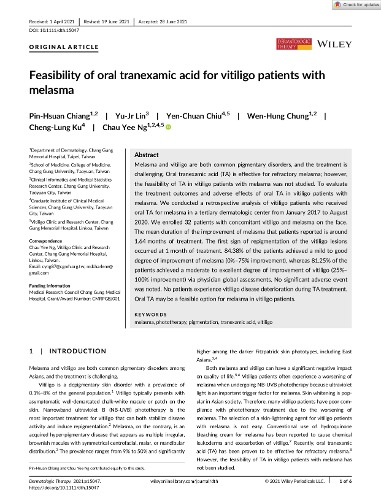Publications
- Home
- Publications
- Research Publications
- Feasibility of Oral Tranexamic acid (TA) for Vitiligo Patients with Melasma
Feasibility of Oral Tranexamic acid (TA) for Vitiligo Patients with Melasma

Abstract:
Melasma and vitiligo are both common pigmentary disorders, and the treatment is challenging. Oral tranexamic acid (TA) is effective for refractory melasma; however, the feasibility of TA in vitiligo patients with melasma was not studied. To evaluate the treatment outcomes and adverse effects of oral TA in vitiligo patients with melasma. We conducted a retrospective analysis of vitiligo patients who received oral TA for melasma in a tertiary dermatologic center from January 2017 to August 2020. We enrolled 32 patients with concomitant vitiligo and melasma on the face. The mean duration of the improvement of melasma that patients reported is around 1.64 months of treatment. The first sign of repigmentation of the vitiligo lesions occurred at 1 month of treatment. 84.38% of the patients achieved a mild to good degree of improvement of melasma (0%–75% improvement), whereas 81.25% of the patients achieved a moderate to excellent degree of improvement of vitiligo (25%–100% improvement) via physician global assessments. No significant adverse event was noted. No patients experience vitiligo disease deterioration during TA treatment. Oral TA may be a feasible option for melasma in vitiligo patients.FAQ Classification
Related FAQ
- A comparative study of an advanced skin imaging system in diagnosing facial pigmentary and inflammatory conditions
- From zero to one: Recent advances in the pathogenesis, diagnosis, and treatment of vitiligo.
- Skin Interstitial Fluid and Plasma Multiplex Cytokine Analysis Reveals IFN-γ Signatures and Granzyme B as Useful Biomarker for Activity, Severity and Prognosis Assessment in Vitiligo
- Targeting the elevated IFN - γ in vitiligo patients by human anti - IFN - γ monoclonal antibody hampers direct cytotoxicity in melanocyte
- Pathogenic autoantibodies to IFN-γ act through the impedance of receptor assembly and Fc-mediated response
- A comparative study of suction blister epidermal grafting and automated blister epidermal micrograft in stable vitiligo
- Efficacy and safety of automated epidermal micrograft in patients with stable segmental and nonsegmental vitiligo
- Feasibility of High-Cellular-Resolution Full-Field, Artificial-Intelligence-Assisted, Real-Time Optical Coherence Tomography in the Evaluation of Vitiligo: A Prospective Longitudinal Follow-Up Study.
- Association of multiple sclerosis with vitiligo: a systematic review and meta- analysis
- Vitiligo associated with polycaprolactone-based collagen stimulator filler

